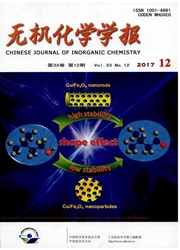

 中文摘要:
中文摘要:
Treatment of CptRh(PMe3)Cl2(1) (Cpt=5η-tBu2C5H3) with [Et4N]2Se6 in DMF solution leads to the for-mation of cyclo-tetraselenido half-sandwich rhodium com-plexes CptRh(PMe3)(Se4) (2). The elimination of 2 with ex-cess of nBu3P results in cyclo-diselenido rhodium complex CptRh(PMe3)(Se2) (3). 1 reacts with [nBu4N]2Te5 in DMF solution to yield cyclo-ditellurido rhodium complex CptRh (PMe3)(Te2) (4) in which carbon atom from CH2C12 can be inserted into Te-Te bond to form CptRh(PMe3)(TeCH2Te) (5). The new complexes 2-5 have been characterized by their IR, EI-MS, and 1H, 13C, 31P, 103Rh NMR spectra as well as ele-mental analysis.
 英文摘要:
英文摘要:
Treatment of CptRh(PMe3)Cl2(l) (Cpt = 5 η-tBu2C5H3) with [Et4N]2Se6 in DMF solution leads to the formation of cyclo-tetraselenido half-sandwich rhodium complexes CptRh(PMe3)(Se4) (2). The elimination of 2 with excess of nBu3P results in cyclo-diselenido rhodium complex CptRh(PMe3)(Se2) (3). 1 reacts with [nBu4N]2Te5 in DMF solution to yield cyclo-ditellurido rhodium complex Cp_tRh (PMe3)(Te2) (4) in which carbon atom from CH2C12 can be inserted into Te-Te bond to form CptRh(PMe3)(TeCH2Te) (5). The new complexes 2–5 have been characterized by their IR, EI-MS, and 1H, 13C, 31P, 103Rh NMR spectra as well as elemental analysis.
 同期刊论文项目
同期刊论文项目
 同项目期刊论文
同项目期刊论文
 期刊信息
期刊信息
